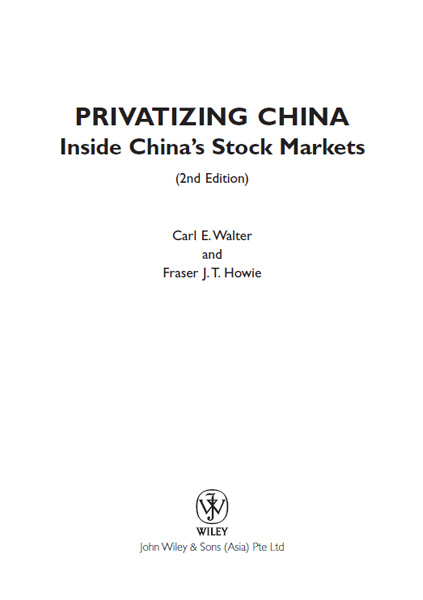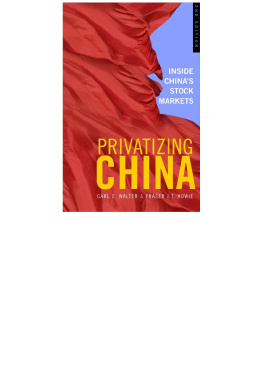Fraser J. T. Howie - Privatizing China
Here you can read online Fraser J. T. Howie - Privatizing China full text of the book (entire story) in english for free. Download pdf and epub, get meaning, cover and reviews about this ebook. year: 2011, genre: Politics. Description of the work, (preface) as well as reviews are available. Best literature library LitArk.com created for fans of good reading and offers a wide selection of genres:
Romance novel
Science fiction
Adventure
Detective
Science
History
Home and family
Prose
Art
Politics
Computer
Non-fiction
Religion
Business
Children
Humor
Choose a favorite category and find really read worthwhile books. Enjoy immersion in the world of imagination, feel the emotions of the characters or learn something new for yourself, make an fascinating discovery.
- Book:Privatizing China
- Author:
- Genre:
- Year:2011
- Rating:3 / 5
- Favourites:Add to favourites
- Your mark:
- 60
- 1
- 2
- 3
- 4
- 5
Privatizing China: summary, description and annotation
We offer to read an annotation, description, summary or preface (depends on what the author of the book "Privatizing China" wrote himself). If you haven't found the necessary information about the book — write in the comments, we will try to find it.
Privatizing China — read online for free the complete book (whole text) full work
Below is the text of the book, divided by pages. System saving the place of the last page read, allows you to conveniently read the book "Privatizing China" online for free, without having to search again every time where you left off. Put a bookmark, and you can go to the page where you finished reading at any time.
Font size:
Interval:
Bookmark:

Copyright 2009 John Wiley & Sons (Asia) Pte. Ltd.
Published in 2009 by John Wiley & Sons (Asia) Pte. Ltd.
2 Clementi Loop, #02-01, Singapore 129809
All rights reserved.
No part of this publication may be reproduced, stored in a retrieval system, or transmitted in any form or by any means, electronic, mechanical, photocopying, recording, scanning, or otherwise, except as expressly permitted by law, without either the prior written permission of the Publisher, or authorization through payment of the appropriate photocopy fee to the Copyright Clearance Center. Requests for permission should be addressed to the Publisher, John Wiley & Sons (Asia) Pte. Ltd., 2 Clementi Loop, #02-01, Singapore 129809, tel: 65-64632400, fax: 65-64646912, e-mail: enquiry@wiley.com.sg.
This publication is designed to provide accurate and authoritative information in regard to the subject matter covered. It is sold with the understanding that the publisher is not engaged in rendering professional services. If professional advice or other expert assistance is required, the services of a competent professional person should be sought.
Other Wiley Editorial Offices
John Wiley & Sons, 111 River Street, Hoboken, NJ 07030, USA
John Wiley & Sons, The Atrium, Southern Gate, Chichester, West Sussex, P019 8SQ, United Kingdom
John Wiley & Sons (Canada) Ltd., 5353 Dundas Street West, Suite 400, Toronto, Ontario, M9B 6HB, Canada
John Wiley & Sons Australia Ltd, 42 McDougall Street, Milton, Queensland 4064, Australia
Wiley-VCH, Boschstrasse 12, D-69469 Weinheim, Germany
Library of Congress Cataloging-in-Publication Data:
ISBN 13-978-0-470-82214-0
ISBN 10-0-470-82214-7
Once again, for our families and friends
Preface
Three years have passed since the publication of Privatizing China, which we thought presented a definitive version of China's stock markets after a decade of development. Writing in late 2002, when the notional capitalization of the markets, at more than US$500 billion, was the second largest in non-Japan Asia, we were optimistic that it was poised to break through the obstacles holding it back. After all, China was entering the hottest period of its post-reform development, and talk was ubiquitous about the 21st century belonging to the Chinese. A major investment bank even wrote a report showing that the country's GDP would by mid-century exceed that of the U.S. Entry into a framework leading to full membership in the World Trade Organization in late 2006 led to a boom in China's exports and world recognition of the country's emergence into the global economy. And in truth, the past five years have seen the creation of more wealth in China's coastal cities and provinces than at possibly any time in world history except the post-war U.S. The place has simply boomed. But the stock market together with the securities industry itself collapsed. How, with GDP growth averaging near 10% per annum, could this have happened?
The simple answer is that Deng Xiaoping was wrong: stock markets cannot be successfully adapted to an economy lacking private property and dominated in all important aspects by agencies of the government. As this book attempts to show, the compromises made by the government to prevent stock markets from leading to outright privatization of state-owned companies did create a very vibrant market, just not one for listed companies. They created multiple markets for the shares of the same issuer, each with different rules, regulators, and pricing mechanisms! What is particularly ironic is that a policy designed to prevent state property from falling into private hands was easily twisted by market forces: by year-end 2005, some 26% of listed companies in China were controlled by private individuals.
Then, after nine years of wild speculation and rampant fraud, the government in mid-2001 sought to bring together the two principal domestic marketsA shares and non-tradable shares. What would have been the modest start of a long, drawn-out process to achieve this led directly to the collapse of the A share markets in Shanghai and Shenzhen. The markets continued their fall for four years, losing more than 50% of their value by mid-2005 amid bungled policies, regulatory indecisiveness, and ferocious lobbying by the securities industry to restore the status quo.
During this time, all market stakeholders came to realize that restoring the markets to health would be impossible without resolving the problem of non-tradable shares. Unwilling to take endless losses, retail investors fled the market in drovesby year-end 2005 official reports noted that nearly two-thirds of investor accounts were empty. The consequent decline of trading volume and massive securities fraud drove the industry into bankruptcy. More industry lobbying for a favorable way out resulted in a final solution to the problem of divided markets in mid-2005, the so-called G company reform. Of course, the industry was the principal short term beneficiary. In addition, many of the major securities companies (but not their shareholders) survived bankruptcy thanks to a massive recapitalization led by the central government. How this all happened, and the bureaucratic infighting over the corpse of the securities industry is amply documented in this revised edition.
In spite of the huge market run-up beginning in early 2006, it is too early to know whether the non-tradable share problem has finally been resolved. These shares have been locked up for three years, only after which can their holders monetize them. In other words, the ultimate impact of this final solution has been pushed off onto the plates of future officials. What is clear at this point in time is that China fever is back in strength in the H share, the A share, and the skyrocketing commodities markets. If a conclusion can be drawn at this early date, we believe that very little has yet to change in the practical reality of how China's markets work. Whether China can yet develop a true market, allocating scarce capital to those sectors and companies yielding the highest return remains an open question.
We have had tremendous fun writing and then revising this book. China's stock markets, no matter what else they may do, produce endless stories that illuminate the true character of the economy as a whole and the conundrum faced by a state that desperately seeks modernization on its own terms. No matter how distorted by government intervention, the stock market in China is a market driven by an unceasing demand for capital. What is for sale will be sold so that the ultimate outcome is plain for all to see.
Many people have helped make this book possible, in particular our readers. Over the years, we have received continuous support from them that has encouraged us in what otherwise might only have been seen as an arcane and somewhat academic hobby. There has even been a Chinese translation (Minyinghua zai Zhongguo; ISBN 7-5058-4628-0), which makes us particularly proud. Of course, without the continuing support of the folks at John Wiley & Sons none of this would have happened. Nick Wallwork, our publisher, has been unceasingly supportive, and we are much indebted to him. Our editors, Robyn Flemming and David Rule, have penetrated our arcane facts and obscure prose to produce a much more readable book. Janis Soo and Pauline Pek, who have worked with us on the details of the manuscript have been responsive and fun to deal with. Once again, our families have suffered mightily from our continuing fascination. We promised after the first edition never to do it again, but we were wrong. We are grateful for their understanding and continuing support. This time, no promises!
Font size:
Interval:
Bookmark:
Similar books «Privatizing China»
Look at similar books to Privatizing China. We have selected literature similar in name and meaning in the hope of providing readers with more options to find new, interesting, not yet read works.
Discussion, reviews of the book Privatizing China and just readers' own opinions. Leave your comments, write what you think about the work, its meaning or the main characters. Specify what exactly you liked and what you didn't like, and why you think so.












